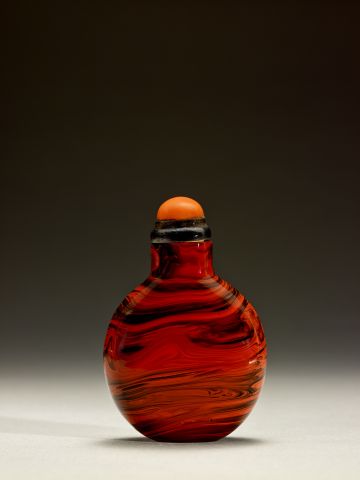
Bottle ID: 704
SWIRLY CINNABAR-RED AND BROWN
Date: 1730-1840
Height: 49 mm
Glass, of flattened, rounded form, with shoulders sloping to a cylindrical neck with a wide mouth, and with a slightly concave oval foot, the glass body with swirls of opaque cinnabar-red and dark mahogany-brown, in imitation of jasper or lacquer.
Attributed to Beijing.
Similar Examples:
Nicollier, Verene. The Baur Collection. Chinese Snuff Bottles, 2007, p.148-149, no. H52
Provenance:
Sotheby's Hong Kong, November 24th, 2014, lot 35
The Collection of Mary and George Bloch
Collection of Gerd Lester, 1986
Sotheby's New York, circa 1977
Published:
Hugh Moss, Victor Graham and Ka Bo Tsang. A Treasury of Chinese Snuff Bottles. The Mary and George Bloch Collection, Volume 5, Hong Kong, 2002, p. 150, no. 709
Although the colors used in the production of this bottle are usually associated with colors imitating realgar, the ensuing result in this case more resembles either jasper or Ming period lacquer-ware. The eighteenth century love for novelty where one material resembles or imitates another continued into the nineteenth century particularly in the production of glass snuff bottles. Sun Tingquan writes of glass resembling "agate of all colors" being produced in Boshan, the primary glass-mkaing area, in the early Qing Period. Later Zhou Jixu seems to suggest that the glass-makers were taking the excess glass from different colored overlays and fusing it all together to make a single plain glass bottle. He writes that this 'results in a variegated scheme of streaks or bands of five different colors. These streaks or bands fit firmly and tightly together and consist of deep voluptuous colors. Although they are mixed they do not merge, so such bottles look as though they were made out of five-colored agate. They are extremely difficult to find. There are also bottles made from blends of such material (heliao); that is they are made out of mixing and merging various colored materials together.' This would have been an efficient way for a commercial glass-maker to produce a bottle that was very appealing and fascinating to the collector without being particularyl time-consuming or expensive.
< Back to full list
 English
English 中文
中文